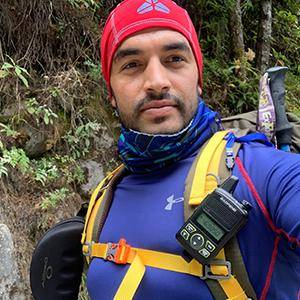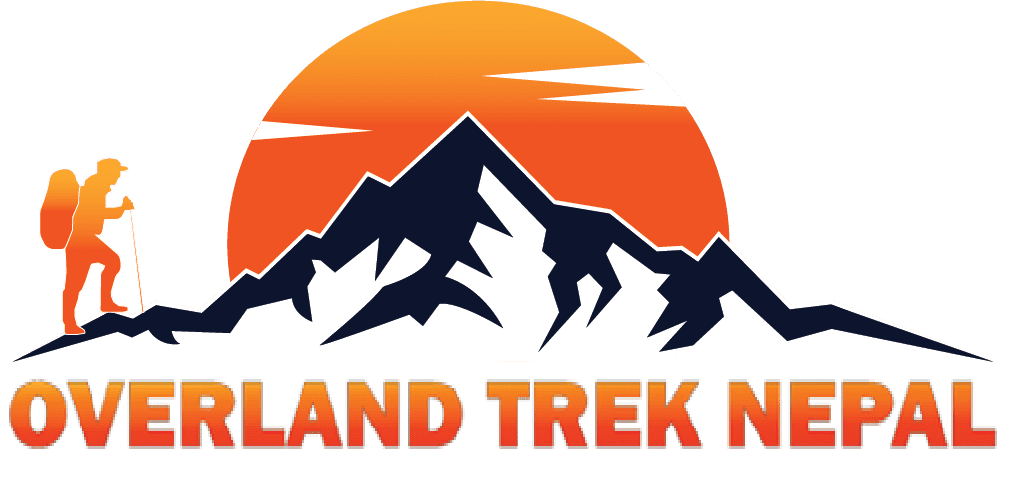The payment is encrypted and
No Booking Fee
No Cancellation Fee

Do not hesitate to give us a call, WhatsApp or email us. We are always there to help you to make your tour safe and entertaining.
Starting on a journey to Mera Peak and Island Peak via the Amphu Labtsa Pass is a dream come true for many adventurers. Overland Trek Nepal offers an unparalleled experience, ensuring safety, adventure, and a deep connection to the majestic Himalayas. This Trip will provide a comprehensive guide, including historical context, high locations, and a detailed day-to-day itinerary with specific timings, activities, and the stunning mountains you will encounter along the way.
Mera Peak (6,476 meters) and Island Peak (6,189 meters) are two of the most sought-after climbing destinations in Nepal. Mera Peak, located in the Mahalangur section, Barun sub-section of the Himalayas, stands as the highest trekking peak in Nepal. Island Peak, also known as Imja Tse, is nestled in the Sagarmatha National Park, offering climbers a spectacular vantage point to view some of the world’s highest peaks, including Everest, Lhotse, and Makalu.
Amphu Labtsa Pass is one of the highest and most challenging passes in the Himalayas at 5,845 meters. It serves as a dramatic connection between the Khumbu and Hinku Valleys, providing trekkers with an exhilarating mix of natural beauty and physical challenge.
Your adventure begins with Overland Trek Nepal, a trusted and experienced trekking company dedicated to providing a seamless and unforgettable experience. From the moment you arrive in Kathmandu, every detail is meticulously planned to ensure your safety and enjoyment.
Overland Trek Nepal is committed, and dedicated to providing an exceptional trekking experience with the highest level of service, ensuring experienced guides, well-planned itineraries, and a commitment to safety and sustainability. Your adventure to Mera Peak and Island Peak via Amphu Labtsa Pass will be a memorable journey of a lifetime.
Upon arrival in Kathmandu, you will be warmly welcomed by Overland Trek Nepal representatives and transferred to your hotel. After settling in, a briefing session will be held to discuss the trip itinerary and essential information. In the evening, explore the vibrant streets of Thamel and enjoy a traditional Nepali dinner.
Maximum Altitude:- 1400m
Meals:- Welcome dinner
Accommodation:- Hotel Three Star Level
Early morning, you will take a scenic flight to Lukla, the gateway to the Everest region. After breakfast in Lukla, begin your trek towards Chutanga. The trail winds through lush forests and traditional Sherpa villages, providing a taste of the region’s rich culture. Enjoy lunch along the way and arrive in Chutanga by late afternoon, where you will stay overnight in a teahouse.
Maximum Altitude:- 3,020 m
Meals:- Breakfast, Lunch & Dinner
Accommodation:- Teahouse
Walking Hours: – 4-5 Hrs
Today is dedicated to acclimatization. After breakfast, take a short hike to higher altitudes, offering stunning views of surrounding peaks. Return to Chutanga for lunch, and spend the afternoon exploring the village and learning about the local way of life. This day ensures you are well-prepared for higher elevations.
Maximum Altitude:- 4,000 m
Meals:- Breakfast, Lunch & Dinner
Accommodation:- Teahouse
Walking Hours: – few Hrs because of Rest Day
After an early breakfast, start your trek towards Thuli Kharka, crossing the Zatrwa La Pass. The climb is challenging but rewarding, with breathtaking views of the Dudh Koshi Valley and distant peaks. Stop for lunch en route, and continue the trek to Thuli Kharka, arriving by late afternoon. Overnight in a teahouse.
Maximum Altitude:- 4,600 m
Meals:- Breakfast, Lunch & Dinner
Accommodation:- Teahouse
Walking Hours: – 6-7 Hrs
Descend through the lush Hinku Valley towards Kothe. The trail meanders through dense forests of rhododendron and pine, with opportunities to spot wildlife. Enjoy a packed lunch and take in the serene beauty of the region. Arrive in Kothe by late afternoon and settle into your teahouse for the night.
Maximum Altitude:- 3,600 m
Meals:- Breakfast, Lunch & Dinner
Accommodation:- Teahouse
Walking Hours: – 5-6 Hrs
The journey continues along the Hinku River, leading to Thangnak. As you ascend, the landscape transforms, offering striking views of Mera Peak. Stop for lunch at a scenic spot and then proceed to Thangnak. Upon arrival, explore the village and rest in preparation for the next day’s trek.
Maximum Altitude:- 4,350 m
Meals:- Breakfast, Lunch & Dinner
Accommodation:- Teahouse
Walking Hours: – 5-6 Hrs
Today is another acclimatization day. After breakfast, take a hike to the surrounding ridges for panoramic views of Mera Peak and other towering giants. Return to Thangnak for lunch, and spend the afternoon resting and hydrating. This day is crucial for adjusting to the higher altitude.
Maximum Altitude:- 5,000 m
Meals:- Breakfast, Lunch & Dinner
Accommodation:- Teahouse
Walking Hours: – 2-3 Hrs
After breakfast, trek towards Khare, the base camp for Mera Peak. The trail offers spectacular views of the Mera Glacier and surrounding peaks. Enjoy lunch en route and reach Khare by early afternoon. Spend the rest of the day preparing for the climb and resting in the teahouse.
Maximum Altitude:- 5,045 m
Meals:- Breakfast, Lunch & Dinner
Accommodation:- Teahouse
Walking Hours: – 3-4 Hrs
This day is dedicated to rest and final preparations for the Mera Peak climb. After breakfast, conduct a gear check and practice climbing techniques. Have a light lunch, and spend the afternoon exploring the nearby areas or relaxing. Early dinner and early to bed to ensure a good night’s sleep.
Maximum Altitude:- 5,400 m
Meals:- Breakfast, Lunch & Dinner
Accommodation:- Teahouse
Walking Hours: – 2-3 Hrs
Begin your ascent to Mera High Camp after an early breakfast. The trail is steep and challenging, but the panoramic views of Everest, Lhotse, and Makalu make it worthwhile. Stop for a packed lunch and continue climbing, reaching the high camp by early afternoon. Settle into your tents and rest for the summit push.
Maximum Altitude:- 5,780 m
Meals:- Breakfast, Lunch & Dinner
Accommodation:- Tent
Walking Hours: – 4-5 Hrs
Wake up early (around 2:00 AM) for a pre-dawn start to the summit. After a light breakfast, begin the climb. The ascent is demanding, but the reward is standing atop Mera Peak, with a 360-degree view of the Himalayas. Spend a few moments at the summit before descending to Khare for a well-deserved rest and celebration dinner.
Maximum Altitude:- 6,476 m
Meals:- Breakfast, Lunch & Dinner
Accommodation:- Teahouse
Walking Hours: – 8-9 Hrs
After breakfast, start your trek towards Kongma Dingma. The trail descends through rocky terrain, offering beautiful views of the surrounding peaks. Stop for lunch along the way and continue to Kongma Dingma, arriving by late afternoon. Overnight in a teahouse.
Maximum Altitude:- 4,850 m
Meals:- Breakfast, Lunch & Dinner
Accommodation:- Teahouse
Walking Hours: – 6-7 Hrs
Today’s trek takes you to Seto Pokhari, a stunning high-altitude lake. The trail is challenging but rewarding, with incredible views of the Amphu Labtsa Pass. Enjoy a packed lunch and continue to Seto Pokhari, where you will camp for the night.
Maximum Altitude:- 5,035 m
Meals:- Breakfast, Lunch & Dinner
Accommodation:- Tent
Walking Hours: – 5-6 Hrs
After an early breakfast, begin the challenging climb over the Amphu Labtsa Pass. The ascent is steep and technical, requiring careful navigation. Enjoy breathtaking views from the pass before descending to the base camp. Have lunch en route and arrive at the base camp by late afternoon. Overnight in tents.
Maximum Altitude:- 5,845 m
Meals:- Breakfast, Lunch & Dinner
Accommodation:- Tent
Walking Hours: – 8-9 Hrs
Start your trek to Chhukung after breakfast. The trail descends into the Imja Valley, offering views of Island Peak and other surrounding mountains. Stop for lunch and continue to Chhukung, arriving by late afternoon. Settle into your teahouse and prepare for the Island Peak climb.
Maximum Altitude:- 4,730 m
Meals:- Breakfast, Lunch & Dinner
Accommodation:- Teahouse
Walking Hours: – 5-6 Hrs
After breakfast, begin your trek to Island Peak Base Camp. The trail is steep and challenging, but the views are stunning. Enjoy lunch en route and reach the base camp by early afternoon. Spend the rest of the day preparing for the climb and resting in your tents.
Maximum Altitude:- 5,200 m
Meals:- Breakfast, Lunch & Dinner
Accommodation:- Tent
Walking Hours: – 4-5 Hrs
Wake up early (around 2:00 AM) for the summit attempt. After a light breakfast, start the climb. The ascent is demanding but incredibly rewarding, with spectacular views from the summit. After celebrating your achievement, descend back to Chhukung for a well-deserved rest and celebration dinner.
Maximum Altitude:- 6,189 m
Meals:- Breakfast, Lunch & Dinner
Accommodation:- Teahouse
Walking Hours: – 8-9 Hrs
After breakfast, begin your descent towards Tengboche. The trail passes through beautiful rhododendron forests and offers stunning views of Ama Dablam and Everest. Stop for lunch along the way and continue to Tengboche, arriving by late afternoon. Visit the famous Tengboche Monastery and stay overnight in a teahouse.
Maximum Altitude:- 3,860 m
Meals:- Breakfast, Lunch & Dinner
Accommodation:- Teahouse
Walking Hours: – 5-6 Hrs
Continue your descent to Namche Bazaar after breakfast. The trail winds through forests and traditional Sherpa villages. Stop for lunch and explore the bustling town of Namche Bazaar upon arrival. Stay overnight in a comfortable lodge.
Maximum Altitude:- 3,440 m
Meals:- Breakfast, Lunch & Dinner
Accommodation:- Teahouse
Walking Hours: – 6-7 Hrs
After breakfast, trek back to Lukla, enjoying the final views of the Everest region. Stop for lunch along the way and arrive in Lukla by late afternoon. Celebrate the completion of your trek with a farewell dinner and stay overnight in a lodge.
Maximum Altitude:- 2,860 m
Meals:- Breakfast, Lunch & Dinner
Accommodation:- Teahouse
Walking Hours: – 7-8 Hrs
Take an early morning flight back to Kathmandu. Upon arrival, transfer to your hotel and spend the rest of the day at leisure. Explore the city’s historic sites or relax in the comfort of your hotel. In the evening, enjoy a farewell dinner with your trekking team.
Maximum Altitude:- 1,400 m
Meals:- Breakfast & Dinner
Accommodation:- Three Star Level Hotel
Flight Duration : – 25-30 mint
After breakfast, transfer to the airport for your departure flight, bringing your incredible journey with Overland Trek Nepal to a close.
Coming Soon
Climbing Mera Peak and Island Peak via Amphu Labtsa Pass is a challenging endeavor, suitable for experienced trekkers and climbers. The journey involves crossing high-altitude passes, steep ascents, and technical climbing sections. Key challenges include:
The best seasons for Mera Peak and Island Peak climbing via Amphu Labtsa Pass are:
To undertake this trek with Overland Trek Nepal, you will need:
Climbing preparation is crucial for a successful and safe expedition:
Comprehensive travel insurance is mandatory for this trek. Ensure your policy covers:
Internet connectivity is limited in remote areas. Some teahouses may offer Wi-Fi for a fee. Mobile network coverage is available in certain locations; consider a local SIM card for better connectivity.
Overland Trek Nepal is renowned for its expertise, experienced guides, and commitment to safety. The company offers meticulously planned itineraries, ensuring a memorable and rewarding adventure. Whether you’re an experienced climber or a passionate trekker, Overland Trek Nepal provides the support and services needed for a successful expedition to Mera Peak and Island Peak via Amphu Labtsa Pass
The best seasons for this expedition are spring (March to May) and autumn (September to November). During these times, the weather is relatively stable, and visibility is excellent, providing stunning views of the Himalayas. Additionally, the temperatures are moderate, making the trek more comfortable.
For this expedition, you will need several permits:
The climb is considered challenging due to its high altitude and demanding terrain. It requires good physical fitness, stamina, and some basic mountaineering skills, including the use of crampons, ice axes, and ropes. Prior experience with high-altitude trekking or climbing is highly recommended.
The key highlights include:
